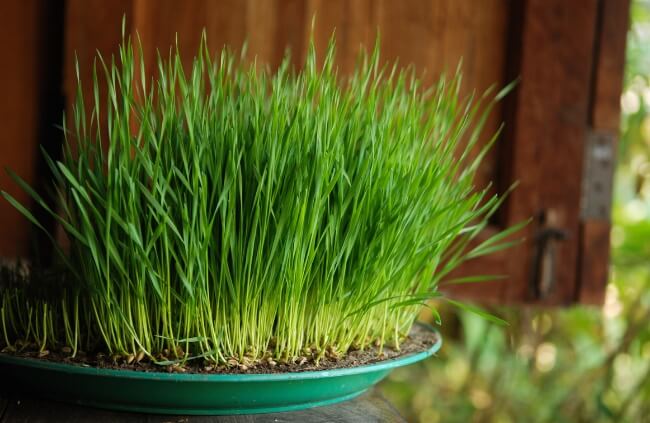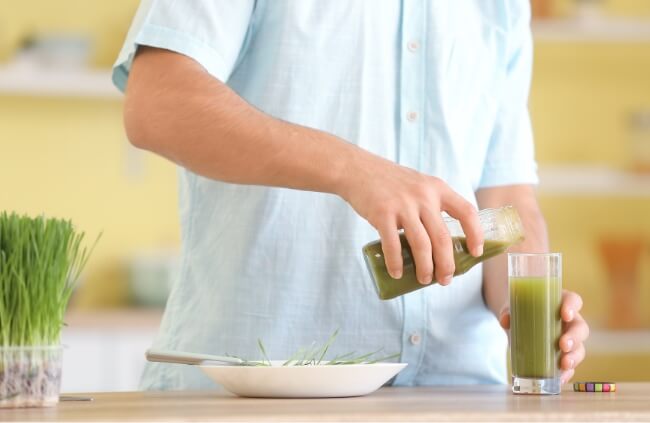Wheatgrass Juice is one of the richest sources of Iron and hence is more sought after than Spinach or Broccoli. Also, it is also one of the expensive juices in the packed juices category.
The readymade alternatives include the bottled juices and wheatgrass powders which can be mixed with water to have the Wheatgrass Juice. But, when it comes to the nutrition content of the freshly prepared juice, all the market alternatives are overridden.
More...
So, what to do??? You don’t have wheatgrass or don’t know how to grow it??? Or you are too busy to grow it on your own?? Or you don’t have the space to grow it??? Or it's just that you don’t know HOW to grow it??
We have the answer to all of these brain storming questions. Here is a complete STEP BY STEP process to grow wheatgrass and to juice it down.
How to Grow Wheatgrass

Wheatgrass can be grown at home in small pots as it is not heavy. Also you can grow as per your requirement and make fresh juice whenever you want without worrying over the degradation of Iron Content.
- To grow wheatgrass, you need wheat grains, a container, sieve or a small cloth and normal tap water.
- Wash the wheat grains with water and soak them in water for 12 hours or a day and keep the container covered.
- After getting soaked the grains will increase in their size. Remove them from the container after 12 hours or ONE day. Rinse them under running water and drain out the remaining water.
Sprouting the Wheat Grains
- The next step will be to SPROUT the wheat grains, which can be done in the following ways:
- Spread the wheat grains on a colander or sieve and cover them with a DAMP cloth.
- WRAP the grains in a wet cloth and keep them in a container.
- It will require around 12 hours SPROUTING the wheat grains.
(Be sure to read our detailed guide about sprouting jars and how it'll help you make sprouting easier.)
Sowing the Wheat
The next step will be to SOW the wheat:
- The wheatgrass is not heavy and small makeshift pots can be used for the purpose.
- Fill your pot quarter way with the soil, make it damp, and put a thin layer of SPROUTED wheat grains on it. Make sure that there is soil visible beneath them.
- Sometimes, the wheat grains don’t grow and if you put only a few seeds in the soil, the odds of getting good yield of wheatgrass are less.
- Then cover the seeds with soil, sprinkle it over with water and cover the pot with a damp cloth.
- Keep that cloth on the pot for 2-3 days and water its top twice a day.
Growing Wheatgrass
- After 2 or 3 days, you will see some green or white blades of wheatgrass coming out of the cloth and after that you can remove the cloth from the pot.
- Keep on watering the grass TWICE a day to keep the soil moisten.
- After a week, the wheatgrass blades will attain a length of 5 inches and after 10 days, they will grow to 6 to 7 inches. That is when they are ready to be JUICED.

Juicing Wheatgrass
Now, the task of growing wheatgrass is over and all that’s left to do is JUICING. The whole process is as follows:
- Cut the wheatgrass, just above the white portion of the stalk and wash it thoroughly under the tap water.
- You can use a simple kitchen blender, add 1 to 2 tablespoons of water to it and churn out the juice. OR you can also juice the grass in the WHEATGRASS Juicer if you have it.
- With the wheatgrass juicer, the pulp will emerge on one side and juice on the other.
- Use a tea strainer or sieve and press the pulp to squeeze out any left out juice. Discard the pulp and you have your FRESH, INEXPENSIVE, HEALTHY and HOMEMADE wheatgrass juice.
It is advised to have your wheatgrass juice shots FRESH.
Published on November 10, 2023 by Gary Clarke
Last Updated on December 18, 2023




